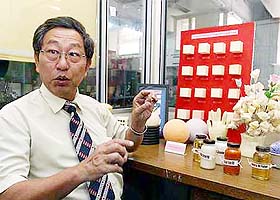There’s a good chance that the comfortable padding on the chair you use every day is made from polyurethane, a chemical-based substance that can be fashioned into foams with varying degrees of flexibility. Polyurethane is used in all kinds of everyday items such as mattresses, cushions, car steering wheels, water hoses, ski boots and even playing surfaces for sports. The polyurethane industry is big business worldwide, with global demand for the product exceeding 10 million tonnes per year.
But there is a downside to polyurethane: it is non-environment friendly since it is derived from petroleum products, a non-renewable resource that is already a scarce commodity worldwide.

SUCCESSFUL FORMULA: Prof Dr Gan Seng Neon showing some of the ingredients and prototypes of the flexible polyurethane foam made from palm oil
In the chemistry laboratories of Universiti Malaya, Professor Dr Gan Seng Neon seems to have found an alternative source for polyurethane, and he revealed this at the recent 14th International Invention, Innovation, Industrial Design and Technology Exhibition in Kuala Lumpur.
Held annually by the Malaysian Invention and Design Society, the exhibition showcases the creative talents of scientists and inventors, and awards prizes for outstanding projects and inventions. Prof Gan showed the result of his research project called “Making Flexible Polyurethane Foams From Palm Oil” at the exhibition, and won a gold medal for his innovative work. Prof Gan, who has been teaching chemistry for more than 20 years, is knowledgeable in all branches of the subject but his area of expertise is polymer chemistry.
“The word ‘polymer’ is a Greek word. ‘Poly’ means ‘many’ and ‘mer’ is from ‘meros’ and it means ‘identical parts’,” he explains. “Actually it refers to a very large molecule where you can identify a lot of repeating units.” Polymers are commonly used in everyday items such as paint, says Prof Gan. “Paint is a pigment that gives colour but you need the polymer to hold the pigment to the wall. You cannot just simply put the colour on the wall because the paint won’t stick. Even the wind will be able to blow it off,” he says with a laugh.
Prof Gan, who keeps up to date with developments in polymer chemistry, read that someone had managed to use castor oil to make rigid foam from polyurethane, a type of foam generally used for insulation. This set him thinking about the feasibility of making rigid foam using palm oil. He tried it, and was successful. “Then I thought, why don’t we make flexible foam because it will be more useful,” he relates.
After two years of research and hundreds of hours in the laboratory, Prof Gan successfully found a formula to create flexible polyurethane foam using palm kernel oil. “Initially, I worked on this project alone but later on I engaged a research assistant to help me,” he says, adding that he intends to pass his knowledge on to his Master’s students. There are many types of foams in the market but polyurethane foam is among the best, says Prof Gan. “Polystyrene foam, for example, is used for packaging but cannot withstand high temperatures and exposure to light. If you use this type of foam to make car seats, it won’t last.” On the other hand, polyurethane foam is far more durable, he says.
“Car seat cushions, the good mattresses, the expensive armchairs are made out of polyurethane foam. Polyurethane is a very useful material and flexible foams made from it are used extensively. They are made into big slabs and cut into sheets to be used in the finished products.”
“Any application you can think of for plastic can be replaced by polyurethane. It’s just that it is a higher end product and more expensive because it has special features such as resistance to heat and UV light.” Prof Gan is confident that his formula of using palm oil as a base product will only add to the advantages of polyurethane foam. “The price of petroleum is high and palm oil-based products are now cheaper. Palm oil is our national product, and making polyurethane foam out of it will help diversify the industry. This will ultimately contribute to the national economy.” The processing costs and capitol costs will be lower for palm oil-derived polyurethane foam than the traditional petroleum-based ones, he adds.
The most important advantage is that polyurethane foam made from palm oil is environment-friendly, although it is not biodegradable. “There are two different classes of environment-friendly materials. One is biodegradable, so as not to pollute the environment. The other class is durable material that is not biodegradable,” Prof Gan explains. “It (polyurethane foam) has to be durable because you do not want your steering wheel or mattress to be biodegradable. “The aspect that contributes to the environment is palm oil, which is a sustainable resource because it is a plant, unlike petroleum chemicals.”
Prof Gan says he is in the midst of applying for a patent for the product and the patent will be in the name of the university. “I am employed by the university and the patent belongs to the university,” he says. Coming up with the idea of creating polyurethane foam out of palm oil was one thing, he says. The road to getting the formula was another, and it required a lot of patience and perseverance.
“Curiosity is one of the main factors that inspired me but breakthroughs along the way are what propelled me to continue my work.”
Source
The Star online July 11, 2004.
Share
Renewable Carbon News – Daily Newsletter
Subscribe to our daily email newsletter – the world's leading newsletter on renewable materials and chemicals










